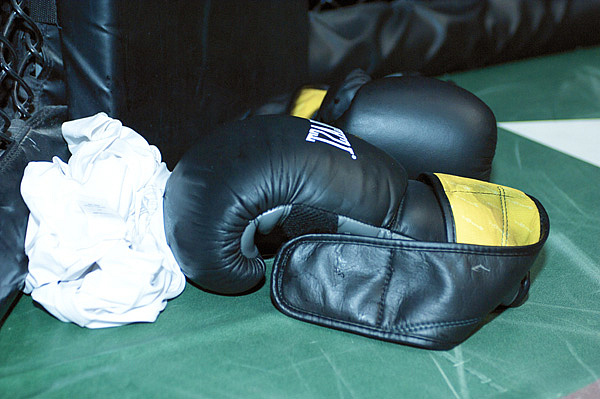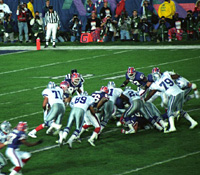Wild West Virginia: A Look Inside a Commission
Tough Enough
Jake Rossen May 21, 2010

File Photo
Advertisement
Toughman’s recruited talent is herded through a screening process that can submit anyone -- like the epileptic Jones -- willing to fib in order to fight. No one is asked for a physician’s note; no eye exams are given, which can endanger those who have gotten Lasik surgery, corrective care that is contraindicated in fighters; six pairs of gloves are re-used throughout, weighed down by the sweat of previous wearers; the frantic, flailing nature of competition inevitably results in mismatches and blows to the back of the head. Plumbers and retail workers will sometimes cross paths with serious men looking to indoctrinate themselves into pro boxing but without the amateur presence in the state to facilitate it.
The record of safety for these amateur melees is not inspiring: 11
men and one woman have died since its inception in 1979. At least
five more have suffered brain damage. Only six states have allowed
events to be scheduled for the spring and summer. Most shun the
event.
“These kids coming in, you just don’t know their backgrounds,” Lueckenhoff said. “I did a little poll of our members and asked who all still regulated Toughman. In several of those responses, people were saying, ‘How could you regulate this? Why haven’t they banned it?’”
“That’s not boxing,” said Virgets. “That’s someone who got into a ring who’s never been there before and who has absolutely no concept of what he could possibly be facing.”
In 1994, casual entrant Bobby Troy DePue fought Terry Vermaelen. DePue had no experience, while Vermaelen had 56 amateur fights. DePue died from injuries sustained in the bout.
Michael Schwartz, M.D., Chairman of the AAPRP, helps oversee combat sports in Connecticut. His commission tasks itself with screening physicals for Toughman that are just as comprehensive as in pro boxing.
“
They’re required to get
CAT scans, blood work, and
physical exams from their
own physicians that state
they’re OK to compete.
”
Allred maintains that his state instructs referees to halt bouts at the first sign of trouble for contestants and that the oversized gear helps protect the ill equipped.
“I’ve refereed some of those very instances where you can see a guy getting in the ring, and one guy has an advantage over the other,” he said. “That’s where your referee comes in, to step in and say, ‘This fight is over.’ It doesn’t make me very popular with the crowd. We’re doing the best we can to make it as safe as we can.”
But concussions can frequently happen from rotational movement of the head, which headgear cannot prevent. More seriously, the tournament elimination means that an athlete could conceivably suffer a head injury in a winning effort and then compete a second or third time that same night. None of the three West Virginia Toughman participants that spoke with Sherdog.com had exams following bouts or immediately prior to their next fight.
It’s that particular oversight that Robert Cantu, M.D., finds disturbing. A sports-focused neurologist, he supported the American College of Sports Medicine’s (ACSM) call for a Toughman ban in 2003 following the death of Florida contestant Stacy Young and the intensive care admission of another brawler that same weekend.
“It routinely allows people who have had concussions to continue with additional bouts,” he said. “It’s possible a fighter, immediately after a fight with the adrenaline running, will completely deny that they’re lightheaded or dizzy. It may not be real easy to pick it up. Whereas over a period of hours, the adrenaline goes away and the symptoms become a little easier to spot. They may even worsen over time. It’s very important every fighter is examined prior to every fight.”
If not, “That sets people up for very serious problems, including death. I think the concept of Toughman -- just anybody wanting to get in the ring can fight -- should be abolished. There should be qualifications to prove that you’ve trained adequately and have adequate skills to defend yourself.”
Oklahoma’s Nathan Johnson, who became the latest fatality in Toughman and Toughman-style events this February, fought twice before refusing to enter a third bout because he felt ill. In March, the state’s medical examiner announced his cause of death as blunt force trauma to the head. Oklahoma’s athletic commission regulated the event.
Despite the modesty of efforts to protect athletes within state lines, West Virginia has one asset that would be the envy of any commission. In the summer of 2009, Julian Bailes, M.D., chairman of the Department of Neurosurgery at West Virginia University, was appointed to the board.
A prominent sports neurologist, Bailes made news in the past two years with research into the long-term effects of football skirmishes on retired professional players. Co-founded with Bennet Omalu, M.D., his Brain Injury Research Institute shamed the National Football League into acknowledging the toll a career of smashing plays can take. The league is now taking aggressive action to keep injured players off the field until they recover.
Bailes fears the same delayed-onset issues could occur in MMA. The sport, with only 10 years of sanctioned competition behind it, has not yet seen several of its competitors in their 50s or 60s, a time when boxers and football players have been shown to experience the cumulative effects of grinding physical contact. In performing autopsies on the brains of several deceased contact athletes, Bailes and Omalu found neurotransmitter damage indicating Chronic Traumatic Encephalopathy (CTE), a progressively destructive disease brought on by trauma.
(The single brain examined that belonged to an MMA fighter was, in Bailes’ estimation, “inconclusive” for CTE.)
“I have great respect and admiration for the MMA participants and what they’ve done,” he said. “The bouts can be exciting….I can enjoy it as a fan. [But] what is my responsibility as a commissioner? If they want to have their rights, they can do it somewhere else. But in my state under my commission’s watch, do I want that? I take the position that I don’t think we should.”
Bailes acknowledged Toughman would seem to be a contradiction of that thought process.

Gary Kaplan Video
LLC/Splash
Bailes may find that crusade difficult to navigate. Toughman’s tenure in the state appears to be fixed in concrete, with the full endorsement of Allred’s commission and none of the political persecution the franchise has experienced in other states.
It’s so firmly rooted that some frustrated advocates of MMA in the state have lobbied charges that promoter Thomas is using his influence to keep MMA out of the area, fearful consumer dollars would be redirected toward an influx of new promoters.
Allred described the idea of an alliance with Thomas as something that “doesn’t even deserve a comment.” Allred’s brother Scott, a former Toughman participant, has worked as an official for Thomas’ promotion.
“The two promoters here control the athletic commission,” said one martial arts instructor in the state. “The reason they don’t want MMA to come is because they’ll lose the game they have going.”
Both Thomas and Rough ‘N Rowdy promoter Chris Smith have organized MMA events in neighboring states -- Smith with 19 total, Thomas with at least six. Both were quoted in press as being advocates of the sport, but Smith later lambasted the idea, citing injuries seen in other events. He still sells DVDs of MMA competition on his Web site. (Neither Smith nor Thomas returned calls seeking comment.)
Even if they embraced MMA in the state, said promoter McCase, “one night is not even close to being as profitable as two.” Two people interviewed for this piece claimed they had engaged in email exchanges or phone conversations where Smith or Allred acknowledged MMA could have an adverse effect on boxing in West Virginia or in other states. Posting on a BoxRec.com forum in April 2007, Allred entered a discussion about MMA and declared, “I am obviously biased in favor of boxing.”
But Lueckenhoff believes the reason for MMA’s blacklist is less sinister. “If they legalize MMA, the commission is going to work every weekend,” he said. “Who knows if they really want to do that? Taking a job that barely pays anything and working every weekend, too? That’s the truth of the matter.”
Profato agreed. “Allred just would have too much on his plate,” he said. “That’s why he may be reluctant to take it on. I don’t know he could guarantee the safety of the fighters. I think if he had resources, he might be more willing. I think he’s truly concerned for the safety of the people.”
Allred rejected the notion: “The commission is not just me. We have five members. The final say is with the legislature. But I can assure you, next year I’ll be right there opposing it whether I’m on the commission or not.”
Allred’s appointment is due to expire in June 2011. In the interim, Toughman will likely continue. Jerry Jones, the epileptic who competed this past March, thought it was remarkable that he wasn’t asked to provide a physician’s note, that no doctor examined him after a preliminary fight, and that in another event he was declared “OK” despite feeling “stunned and dizzy” after a man he had backed into a corner struck him directly on the back of the head.
Jones is not his real name. He asked to remain anonymous because he intends to fight again.
If another MMA bill comes up for discussion during the 2011 sessions, delegates might again be tasked with sorting through Allred’s folder of dissention, a docket distributed to legislators and a copy of which is currently housed in the Legislative Analyst’s Office. There are the letters from Millman, from Bailes, Reilly’s presentation and even a non-sequitur mention of deceased pro wrestler Chris Benoit.
Former chairman Modesitt wrote a letter that uses the phrase “human cockfighting,” though he told Sherdog.com that events he witnessed recently “weren’t nearly as bad” as he expected. There’s a statement of opposition from Gary Toney, a former amateur boxing regulator who made no such advances against Toughman, an activity he labeled as something “that caters to people off the streets” in 2004.
Mixed in with the paperwork is a business card. In case the documents’ readers have any questions, they can feel free to phone Jerry Thomas.
For comments, e-mail the author at [email protected].







